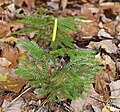Lycophyte
Lycophytes are a group of vascular plants that are among the oldest living terrestrial plants. They belong to the division Lycopodiophyta, which includes some of the most ancient plants known to science. Lycophytes are characterized by their unique leaf structure, known as microphylls, which distinguishes them from the more commonly known ferns and seed plants, which have megaphylls. This article provides an overview of lycophytes, including their history, classification, and ecological significance.
History[edit]
Lycophytes first appeared in the fossil record during the Silurian period, about 420 million years ago. They were among the dominant plant groups during the Carboniferous period, contributing significantly to the formation of coal deposits. During this time, some lycophytes, such as the now-extinct genus Lepidodendron, grew to the size of modern trees. However, the majority of contemporary lycophytes are much smaller, often resembling mosses or small shrubs.
Classification[edit]
The division Lycopodiophyta is divided into three main orders: Lycopodiales, Selaginellales, and Isoetales. Each of these orders has distinct characteristics:
- Lycopodiales - This order includes the clubmosses, which are characterized by their simple, scale-like leaves and sporangia (spore-producing structures) located at the bases of the leaves or in terminal cones.
- Selaginellales - Known as spike mosses, members of this order have leaves that are often arranged in a spiral pattern, with sporangia contained within strobili (conelike structures).
- Isoetales - The quillworts, belonging to this order, are aquatic or semi-aquatic plants with a rosette of leaves rising from a central corm. They have a unique method of spore production, with megaspores and microspores produced in different sporangia.
Ecological Significance[edit]
Lycophytes play a crucial role in their ecosystems. They are often pioneer species, colonizing bare and disturbed soils where they contribute to soil stabilization and the accumulation of organic matter. In some regions, lycophytes are important components of the understory vegetation in forests, where they provide habitat and food for various animals. Additionally, their historical significance as major contributors to coal formation highlights their role in the global carbon cycle.
Conservation[edit]
Many lycophyte species are considered to be of conservation concern due to habitat destruction, climate change, and overcollection. Efforts to conserve these ancient plants are crucial for maintaining biodiversity and the integrity of the ecosystems they inhabit.
See Also[edit]
-
Lycophyte
-
Lycophyte
-
Lycophyte
-
Lycophyte
-
Lycophyte
-
Lycophyte
-
Lycophyte
-
Lycophyte
-
Lycophyte
-
Lycophyte
-
Lycophyte
-
Lycophyte
Ad. Transform your life with W8MD's Budget GLP-1 injections from $75


W8MD offers a medical weight loss program to lose weight in Philadelphia. Our physician-supervised medical weight loss provides:
- Weight loss injections in NYC (generic and brand names):
- Zepbound / Mounjaro, Wegovy / Ozempic, Saxenda
- Most insurances accepted or discounted self-pay rates. We will obtain insurance prior authorizations if needed.
- Generic GLP1 weight loss injections from $75 for the starting dose.
- Also offer prescription weight loss medications including Phentermine, Qsymia, Diethylpropion, Contrave etc.
NYC weight loss doctor appointmentsNYC weight loss doctor appointments
Start your NYC weight loss journey today at our NYC medical weight loss and Philadelphia medical weight loss clinics.
- Call 718-946-5500 to lose weight in NYC or for medical weight loss in Philadelphia 215-676-2334.
- Tags:NYC medical weight loss, Philadelphia lose weight Zepbound NYC, Budget GLP1 weight loss injections, Wegovy Philadelphia, Wegovy NYC, Philadelphia medical weight loss, Brookly weight loss and Wegovy NYC
|
WikiMD's Wellness Encyclopedia |
| Let Food Be Thy Medicine Medicine Thy Food - Hippocrates |
Medical Disclaimer: WikiMD is not a substitute for professional medical advice. The information on WikiMD is provided as an information resource only, may be incorrect, outdated or misleading, and is not to be used or relied on for any diagnostic or treatment purposes. Please consult your health care provider before making any healthcare decisions or for guidance about a specific medical condition. WikiMD expressly disclaims responsibility, and shall have no liability, for any damages, loss, injury, or liability whatsoever suffered as a result of your reliance on the information contained in this site. By visiting this site you agree to the foregoing terms and conditions, which may from time to time be changed or supplemented by WikiMD. If you do not agree to the foregoing terms and conditions, you should not enter or use this site. See full disclaimer.
Credits:Most images are courtesy of Wikimedia commons, and templates, categories Wikipedia, licensed under CC BY SA or similar.
Translate this page: - East Asian
中文,
日本,
한국어,
South Asian
हिन्दी,
தமிழ்,
తెలుగు,
Urdu,
ಕನ್ನಡ,
Southeast Asian
Indonesian,
Vietnamese,
Thai,
မြန်မာဘာသာ,
বাংলা
European
español,
Deutsch,
français,
Greek,
português do Brasil,
polski,
română,
русский,
Nederlands,
norsk,
svenska,
suomi,
Italian
Middle Eastern & African
عربى,
Turkish,
Persian,
Hebrew,
Afrikaans,
isiZulu,
Kiswahili,
Other
Bulgarian,
Hungarian,
Czech,
Swedish,
മലയാളം,
मराठी,
ਪੰਜਾਬੀ,
ગુજરાતી,
Portuguese,
Ukrainian











